Why Did My Windshield Wipers Stop Working

The rhythmic swish of windshield wipers, a sound as familiar as the hum of the engine, is often taken for granted. But what happens when that reassuring sound vanishes, leaving you stranded in a downpour, staring at a blurred world? “Why did my windshield wipers stop working?” is a question that can quickly turn from minor inconvenience to a major safety hazard. While the immediate answer might involve a blown fuse, worn wiper blades, or a faulty motor, the future of windshield cleaning is poised for a radical transformation, blurring the lines between mechanical simplicity and sophisticated automotive technology.
Beyond the Blade: The Evolution of Visibility
For over a century, the fundamental design of windshield wipers has remained surprisingly consistent. A motor drives a mechanical linkage, moving rubber blades across the glass. While innovations like intermittent wipers and rain sensors have improved the experience, the core principle hasn't changed. However, the rise of electric vehicles (EVs), advanced driver-assistance systems (ADAS), and the ever-increasing integration of technology into our cars are driving a paradigm shift. We’re moving beyond the blade, exploring alternative solutions for maintaining clear visibility.
One promising avenue is ultrasonic windshield cleaning. Imagine a system that uses high-frequency sound waves to vibrate dirt, water, and ice off the windshield, leaving a streak-free surface without any physical contact. This technology, already in development, promises to be more efficient, less prone to wear and tear, and significantly quieter than traditional wipers. The integration of this system with ADAS cameras is particularly exciting. Consistent, crystal-clear visuals are critical for autonomous driving, and ultrasonic cleaning could play a pivotal role in ensuring reliable sensor performance in all weather conditions.
Another fascinating area of research focuses on hydrophobic coatings. These advanced materials create a surface so water-repellent that raindrops simply bead up and roll away, minimizing the need for wipers altogether. While current hydrophobic coatings require frequent reapplication, scientists are working on durable, self-healing versions that could last for years. In the context of EVs, reducing the reliance on mechanical wipers can also improve energy efficiency, albeit marginally, by lowering the load on the electrical system.
Smart Solutions for a Clearer Future
The future of windshield cleaning isn't just about replacing traditional wipers with novel technologies; it's also about creating intelligent systems that anticipate and respond to changing weather conditions. AI-powered weather forecasting can be integrated with vehicle systems to proactively prepare the windshield for impending rain or snow. Imagine your car automatically activating a heating element in the windshield or applying a hydrophobic coating just before a storm arrives, ensuring optimal visibility from the moment you start driving. This level of proactive intelligence is particularly relevant for hybrid systems, where minimizing energy consumption is paramount. Smarter wiper systems can conserve power by only activating when absolutely necessary, extending the range of the electric motor.
However, the path to these advanced solutions isn't without its challenges. Cost is a major hurdle. Implementing ultrasonic cleaning or developing long-lasting hydrophobic coatings requires significant investment in research and development. Furthermore, ensuring the reliability and durability of these systems in real-world conditions is crucial. They must withstand extreme temperatures, harsh chemicals, and the constant bombardment of road debris. Regulatory hurdles and consumer acceptance also play a role. Convincing drivers to trust a system that doesn't rely on traditional wipers will require rigorous testing and clear communication about the benefits and limitations of the technology.
Embracing the Transformation of Mobility
The evolution of windshield cleaning is a microcosm of the broader transformation happening in the automotive industry. We are moving beyond simply building cars to creating intelligent mobility solutions that are safer, more efficient, and more connected. The integration of AI, advanced materials, and sophisticated sensors is blurring the lines between the physical and digital worlds, creating vehicles that are more responsive to our needs and more aware of their surroundings.
The humble windshield wiper, once a simple mechanical device, is becoming a sophisticated system that leverages cutting-edge technology to enhance safety and convenience. As we embrace this transformation, we must remain mindful of the challenges and ensure that these advancements benefit all drivers. The future of mobility is not just about faster cars or autonomous driving; it's about creating a safer, more sustainable, and more enjoyable driving experience for everyone.
Ultimately, the question "Why did my windshield wipers stop working?" may one day be relegated to the history books. We are on the cusp of a future where clear vision is not just a matter of mechanical ingenuity, but of intelligent systems working in harmony to anticipate and overcome the challenges of the road. Imagine a world where your windshield remains perpetually clear, offering an unobstructed view of the journey ahead, regardless of the weather. This is the future of visibility, and it's closer than you think.
